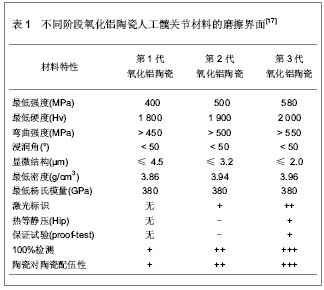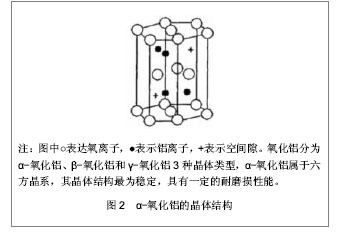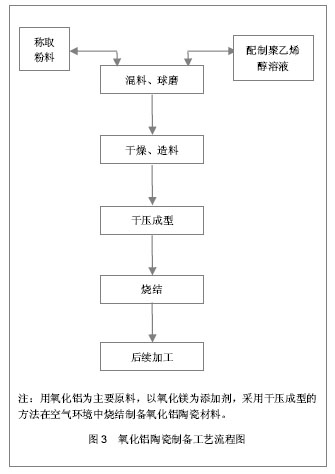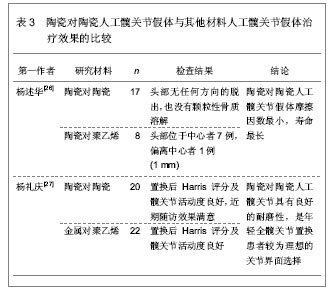3 金属对超高分子量聚乙烯人工髋关节的摩擦界面
金属对超高分子量聚乙烯人工髋关节是目前应用最为广泛的髋关节材料,钴铬钼合金和超高分子量聚乙烯组成具有摩擦因数低、生物相容性好等优点,使用寿命在15-25年[11],存留率大于90%,长期的临床应用结果表明,其稳定性良好。由于超高分子量聚乙烯具有无毒、耐腐蚀、体内不易降解等优点,被作为人工髋关节材料在临床上使用[12],超高分子量聚乙烯内衬的可塑性是金属对金属和陶瓷对陶瓷髋关节假体很难达到的。但超高分子量聚乙烯作为摩擦界面的主要缺点是抗磨损性能较差,使磨损颗粒进入关节和周围组织,造成骨溶解和松动,直接影响人工髋关节假体的远期寿命。聚乙烯磨损颗粒产生的原因有多向摩擦、微接触下疲劳磨损、聚乙烯退变和表面裂纹等。
影响金属对超高分子量聚乙烯人工髋关节假体磨损性能的研究中发现,聚乙烯在与空气接触的条件下消毒产生的自由基会使聚乙烯产生老化现象,γ射线照射或电子束辐射会破坏聚乙烯分子内的碳-碳键或碳-氢键,使主链断裂,与体内的氧分子相互作用使聚乙烯氧化变性,磨损性能降低。而在无氧条件下,γ射线照射或电子束辐射可以引起分子间的交联作用,对抗分子间移动,有效抵抗垂直于分子主链轴平面的形变和磨损,明显提高聚乙烯的抗磨损性能。并且聚乙烯分子的交联和氧化过程之间存在竞争反应,交联作用增加时氧化反应减少,氧化反应增加时交联作用减少。为解决聚乙烯交联和氧化问题,可以通过在惰性环境应用γ射线消毒等方法增加交联率,热熔处理降低自由基残留,可明显提高抗磨损和抗老化性能。射线强度越大交联率越高,耐磨损性能越好,常用的γ射线照射强度为(20-40) kGy,使聚乙烯耐磨性能提高30%-50%,大于50 kGy的射线强度可使耐磨性能提高到85%以上,但过大的射线照射强度会导致材料力学性能的下降,尤其是疲劳强度和抗破裂硬度的下降,因此,对聚乙烯的最佳交联率还存在争议。
4 金属对金属人工髋关节的摩擦界面
由于超高分子量聚乙烯的高磨损率导致的骨溶解和远期松动问题,使金属对超高分子量聚乙烯人工髋关节在年轻患者或高活动量的患者中失败率较高,金属对金属人工髋关节得到重视,并在临床得以越来越广泛的应用。
金属对金属人工髋关节假体的润滑机制主要是混合润滑,润滑液膜的厚度决定了关节的磨损率。摩擦间隙越小,液膜的厚度越大,则摩擦界面的直接接触面越小,磨损也越低,但摩擦间隙太小容易出现边缘接触增加摩擦转矩,结果使磨损增加。摩擦间隙太大则液膜厚度不足以分离摩擦面,易出现点状接触应力从而增加磨损。不同直径的球头,其最合适的摩擦间隙也不一致。金属人工髋关节假体具有良好的润滑性能和极低的磨损率,并不是因为润滑液膜厚度的增加,而是由于制造工艺的改进,使摩擦面的光洁度有了非常大的提高。这种低磨损率使金属对金属人工髋关节允许更薄的金属臼杯,从而可以使用更大的股骨头。而且,金属对金属人工髋关节假体还具有自抛光特性,假体植入体内后,可在日常运动中将各种原因导致的表面刮痕重新抛光,从而具有摩擦界面自行修复的特征。
临床研究结果发现,快速磨损期内金属对金属假体的线性磨损率为25-35 μm/年,进入稳态磨损后,磨损率降低到5 μm/年,容积磨损率为0.3 mm
3/百万周期,比传统的金属对聚乙烯人工髋关节假体低100倍,骨溶解的发生率也非常少。但是金属对金属假体产生的磨损颗粒平均粒径为0.05 μm,按其容积磨损率计算,每年产生的颗粒数为(6.7×10
12)-(2.5×10
14),磨损颗粒可散布于体内各脏器和体液中,使血液和尿液中的金属离子含量迅速升高,容易引起金属离子浓聚、金属过敏、介导免疫反应、金属肾毒性和金属致畸等发生。
 5 陶瓷对陶瓷人工髋关节的摩擦界面
5 陶瓷对陶瓷人工髋关节的摩擦界面
陶瓷对陶瓷人工髋关节假体的设计和固定是经过一系列改进的无机非金属材料,可以分为惰性生物陶瓷和活性生物陶瓷,惰性生物陶瓷是指对机体几乎不发生反应或极小发生反应的陶瓷材料,如氧化铝陶瓷、氧化锆陶瓷等[13],活性生物陶瓷是指与组织界面发生作用,使化学键结合,并诱导骨结合的材料,如羟基磷灰石陶瓷、生物活性玻璃等。根据美国在2005年10月至2006年12月的研究数据表明,在112 095例人工髋关节假体置换的患者中,陶瓷对陶瓷界面的人工髋关节置换占14%,患者以年轻人居多,小于55岁的患者占总人数的24.5%,并且年轻患者中有25.7%应用的是陶瓷对陶瓷界面的人工髋关节[14]。陶瓷对陶瓷人工髋关节假体使用至今已有40余年,产品材料纯度更高,密度更佳,晶体颗粒更小,质量控制更加严格。
5.1 氧化铝陶瓷人工髋关节假体的磨损特点 氧化铝陶瓷在1970年由法国学者Boutin
[15]首次作为人工髋关节材料界面植入到人体,Mittelmeier等
[16]又设计氧化铝陶瓷作为关节界面,在临床治疗中获得大量应用。氧化铝陶瓷人工髋关节的应用历程大致可以分为4个阶段,每个阶段氧化铝陶瓷材料的磨擦界面都有各自的特点,见表1。

目前,临床使用较多的陶瓷材料是第3代氧化铝陶瓷对氧化铝陶瓷的人工髋关节假体,是目前已知的摩擦最低的关节,耐磨损,抗压强度为2 000-4 000 MPa,线性磨损率为0.025-10.000 μm/年。具有极高的表面硬度,无蠕变现象,有利于表面抛光,表面粗糙度更小,可以减少摩擦。陶瓷的表面亲水性能优良,润滑性能出色,使润滑液可以更均匀分布于摩擦面,有助于提高润滑性能。有极好的耐腐蚀性,绝缘性,没有离子释出,不引起细胞反应,不会发生骨溶解。表面退化缓慢,抗疲劳性强。α-氧化铝的晶体结构
[18],见图2。

第4代氧化铝陶瓷其材料密度、强度、韧性均较氧化铝和氧化锆更大,生物相容性及耐磨损性等性能也更优异,因加入氧化锶而呈粉红色,又被称为粉陶。粉陶人工髋关节假体的出现成为髋关节疾病患者的新选择,在临床上的应用也有上升趋势。粉陶人工髋关节的材料具有耐磨损的特征,使用寿命长,避免金属磨屑的不良反应,还具有硬度大等优点。同时,粉陶人工髋关节的抗裂性能有明显提高,可以制成更薄的内衬,使用更大直径的股骨头假体,降低股骨头脱位的发生率,使患者能够获得最大范围的关节活动度,置换后功能恢复良好,可使疼痛得到明显的缓解,经过一段时间的功能锻炼可以恢复正常人的活动范围。因此,第4代粉陶人工髋关节假体是目前国际上最先进的人工髋关节材料。陶瓷-陶瓷组合已被证实是目前最耐磨损的假体组合,并且是年轻髋关节病变患者、对髋关节功能和使用寿命要求较高患者的最佳选择,极大提高了患者治疗后的生活质量。
5.2 氧化铝陶瓷人工髋关节假体的制备工艺 近年来,
对陶瓷人工髋关节假体进行改造,制备工艺也有所改进[18],见图3。

陶瓷人工髋关节假体的先进制备工艺可以得到高度抛光的表面,从而达到球头内衬之间最佳间隙,抛弃球头的裙边设计和严格控制球窝的锥度。被放行的陶瓷与金属部件需要通过严格的破碎实验,破碎载荷达到55-110 kN,相当于5-10倍人体髋关节活动所需承受的应力,而且每个陶瓷部件在出厂前要通过100%的超载无损试验
[19]。
陶瓷对陶瓷人工髋关节假体的主要问题在于股骨头易碎裂、断裂强度以及抗张强度低[20-21]。经过优选材料、制备工艺以及人工假体设计的改进,28 mm陶瓷头的破碎率为0.01%,32 mm陶瓷头的破碎率仅为0.004%,而且,这些破碎多与人工假体安放的位置不良或创伤有关。内衬植入时或假体置换后撞击导致臼杯边缘的破损是较为常见的,不同设计的假体发生率为1.0%-2.6%,采用髋臼杯比内衬稍大的设计可以减少其发生率。此外,正确的操作技术对人工假体的寿命非常重要,陶瓷对陶瓷人工髋关节假体对安装位置要求更高,位置不良极易导致假体撞击,是加速磨损的主要原因。
5.3 影响陶瓷对陶瓷人工髋关节假体磨擦界面的因素
5.3.1 患者因素 临床上摩擦副的选择主要考虑患者因素,包括患者的年龄、身体状况、活动水平、预期寿命和经济状况等因素。年龄在60岁以上,活动量不大的患者,金属对超高分子量聚乙烯人工髋关节假体仍属首选。对于年轻的患者,由于活动量大、预期寿命长,则应优先考虑更耐磨损的陶瓷对陶瓷或金属对金属人工髋关节假体,以期获得较佳的远期效果。在选择金属对金属摩擦副人工髋关节假体时,还必须排除金属过敏和肾功能损害的患者。由于陶瓷人工髋假体尚缺乏国际标准,在陶瓷对陶瓷假体选用时,禁忌混用不同品牌的产品,禁止陶瓷头与金属部件作摩擦副,在假体安装时要保持假体表面状态完好,植入前彻底清洗假体接触面,安装陶瓷头时先轻拧到位再以配套工具轻轻敲击,不能以金属工具直接敲击陶瓷部件。
5.3.2 操作因素 人工髋关节假体安装和使用也是影响摩擦界面寿命的重要因素。陶瓷对陶瓷人工髋关节假体对安装位置非常敏感,安装位置不良,可以出现假体撞击,由此产生的磨损率高于常规磨损率数倍至数10倍。人工全髋关节假体对线不良,可产生假体撞击和异常的假体受力模式,引起线性磨损的明显增加。置换后高活动量和体育运动均可加速假体磨损,对于陶瓷对陶瓷人工髋关节假体摩擦副还可能增加假体破碎概率。因此,重视安装质量和置换后控制适量运动所产生的作用可能超过选择更优良的假体摩擦副。
5.4 陶瓷对陶瓷人工髋关节假体治疗后效果
5.4.1 陶瓷对陶瓷人工髋关节假体置换治疗前后患者基线资料和治疗效果 见表2。

蔡友治等[25]回顾分析第三代氧化铝陶瓷全髋关节置换在中青年患者中的中期临床疗效,收集2001年5月至2006年5月98例行全陶人工髋关节置换患者的临床资料,共获得有效随访患者82例,共89例髋,其中男43例(48髋),女39例(41髋),平均年龄47.6岁,平均随访时间101.9个月(66-120个月),对有效随访的患者均进行临床和影像学检查评估疗效。结果患者置换前Harris评分(49.8±8.0)分(36-65分),置换后末次随访(92.3±2.6)分(86-97分)(P < 0.05)。随访均未见假体破裂,未发生假体周围感染,无翻修病例。1例置换后出现脱位,1例出现关节异响现象,均在非手术治疗后消失。置换后影像学均无可观察到的磨损和骨溶解,无明显异位骨化,无假体松动。研究结果显示第三代氧化铝全陶髋关节假体用于中青年患者初次全髋关节置换,中期临床随访结果满意,是一种良好的治疗选择。
5.4.2 陶瓷对陶瓷人工髋关节假体与其他材料人工髋关节假体治疗效果的比较 见表3。

钟会明
[28]对浙江大学医学院附属第二医院骨科三病区1997年1月至2008年1月收治的年龄小于55岁的62例股骨头无菌性坏死患者采用陶瓷对陶瓷界面和陶瓷对聚乙烯组界面人工全髋关节置换后随访,根据关节面的配伍不同分成两组,即陶瓷对陶瓷组和陶瓷对聚乙烯组,对患者置换后常规随访进行复查拍片,对置换前和置换后随访时的X射线片进行对比分析,评估假体松动和骨溶解情况,并对患者髋关节功能进行临床评价,评价采用Harris评分系统。两组患者经过60-120个月随访,平均84个月,所有患者均未出现感染、骨折、脱位、陶瓷碎裂及神经损伤等并发症,陶瓷对聚乙烯组有2例患者置换后2个月发生深静脉血栓。Harris评分方面,陶瓷对陶瓷组置换前平均为(41.3±2.6)分,最近随访为(90.8±2.6)分;陶瓷对聚乙烯组置换前为(40.3±2.8)分,最近随访为(89.8±2.6)分。置换后无假体松动需要翻修的患者,置换后影像学检查可见关节假体在位,金属臼杯和股骨假体与宿主骨嵌合良好,无明显骨溶解及假体松动。髋关节活动无明显受限,髋关节无疼痛不适,均不使用辅助工具。两组组内间差别在Harris评分方面有明显统计学意义,手术疗效显著。两组组间差别在Harris评分、骨溶解和影像学松动方面无明显统计学意义,由于随访时间有限,远期疗效有待于进一步临床观察。






.jpg)